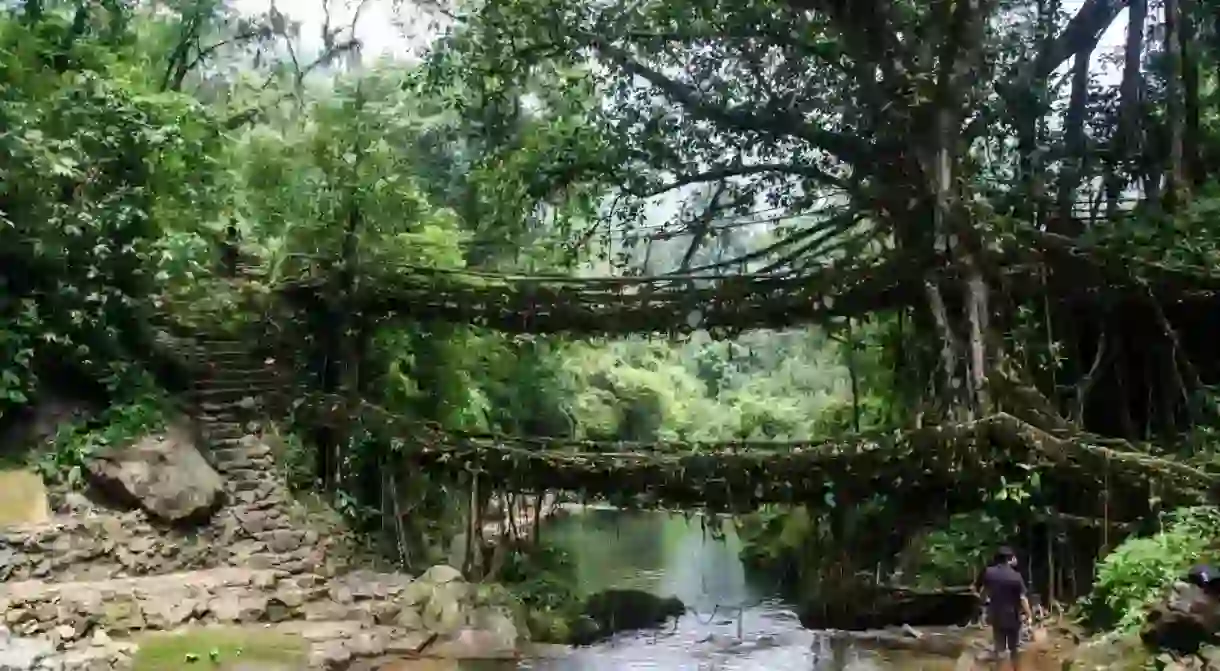India's Amazing Living Root Bridges Will Blow Your Mind

Beautiful bridges built by engineers are not only practical structures but also stunning pieces of art and architecture; when Mother Nature herself becomes the architect, the result is nothing short of breathtaking. The northeastern Indian state of Meghalaya is blessed with such beautiful treasures of natural architecture that will blow your mind: living root bridges.
For the last 180 years, the inhabitants of the two districts of Meghalaya – East Khasi Hills District and West Jaintia Hills District – have been using living root bridges to cross streams and rivers running through the dense tropical forest. These bridges stand tall against the test of time, with a capacity to hold 50 people at a time. Today, these natural wonders are among the popular attractions of this northeastern state of India.

History of living root bridges
With a name that literally means ‘Abode of Clouds’, it’s no surprise that Meghalaya receives abundant rainfall every year. While the rain brings relief to most parts of the state, it brings challenges to the native Khasi tribe, who live in Khasi and Jaintia hill districts of Meghalaya. The incessant monsoons (June–August) result in the swelling of rivers and streams, making it impossible for the locals to cross the river by foot. So the indigenous Khasi tribe erected bridges that could withstand the heavy rains. Initially they constructed bamboo bridges across the rivers, but these structures would decay and break in heavy storms. To combat the feisty monsoon, the Khasi tribe came up with a unique solution: to form bridges from the naturally growing roots of rubber trees (native to the streams and rivers of northeast India) and bonded to betel nut tree trunks.

The rubber tree roots are put into hollow betel nut plant trunks to grow them in the right direction (i.e. over the river); once the roots reach the other side of the stream, they are entrenched into the soil, fortified and stabilized by stones, pebbles and sticks. After 15–20 years, the living bridge is strong enough to withstand heavy weight and becomes stronger with time, as the roots of the still-living trees continue to grow with a life span of about 500 years. Perhaps that’s why growing living root bridges, some 30 metres (100 feet) long, is a tradition passed on through generations of natives.
Where to find living root bridges
These wonderful specimens of natural architecture can be found in East Khasi Hills and West Jaintia Hills districts, but the best ones are in Cherrapunji (also called Sohra) and Mawlynnong. The best time to visit is outside of monsoon season, November–March.

Cherrapunji
Nestled in East Khasi Hills District of Meghalaya, Cherrapunji is head-over-heels grogeious with its beautiful waterfalls, splendid natural beauty, cave exploration and living root bridges.
Double Decker Umshiang Bridge in Nongriat Village
Reaching here is no small accomplishment, so adventure enthusiasts are in for a treat. This 180-year-old double decker bridge – one stacked over the other – hangs 731.5 metres (2,400 feet) above the Umshiang River and measures 20 metres (65.6 feet) long. The one-way trek to this bridge is 3 kilometers (1.8 miles), starting from the Tyrna Village, and demands a lot of stamina, yet the experience and the beautiful spectacle are equally rewarding, plus the waterfall in the foreground adds to the charm.
Nongriat, Cherrapunji, Meghalaya, India

Mawsaw Root Bridge
About 30 minutes past the Nongriat Double Decker Root Bridge is the Mawsaw Root Bridge, which has several nearby natural swimming pools to unwind.
Ritymmen Bridge in Nongthymmai Village
About halfway between Tyrna Village and the Nongriat Double Decker is Ritymmen Root Bridge, which – at 30 metres long (98 feet) – is one of the longest known living root bridges.
Nongthymmai, Cherrapunji, Meghalaya, India

Ummunoi Bridge in Nongkroh Village
Approximately 427 metres (1,400 feet) above the Ummunoi River and 17 metres (54 feet) long, this single root bridge is one of the area’s oldest known living root bridges. Like the Umshiang Bridge, this bridge is a 3 kilometres (1.8 miles) one-way trek from Laitkynsew Village.
Nongkroh, Cherrapunji, Meghalaya, India
Living Root Bridges in Mawlynnong
Just a 10-minute drive from Mawlynnong, Asia’s cleanest village, lies the Riwai village. Walk approximately 300 metres (985 feet) from the village through the forest area to reach the living root bridge, which costs ₹10 (£0.11/$0.15) to enter, funding development of the village.
Riwai, Meghalaya, India

Getting to Cherrapunji and Mawlynnong
Get to Cherrapunji from Guwahati Airport, approximately 123 kilometres (76 miles) from Shillong, then catch a bus to Cherrapunji, another 54 kilometres (33 miles) away. Or start at Guwahati Railway Station, 148 kilometres (92 miles) from Cherrapunji, which can be reached by bus or taxi within 4 hours.
The nearest railway station to Mawlynnong is Guwahati, approximately 172 kilometres (106 miles), while the nearest airport is in Shillong, about 78 kilometres (48 miles) away – visitors can take a bus or taxi the rest of the way.
Several Homestay options are available in the village of Nongriat and Mawlynnong.













